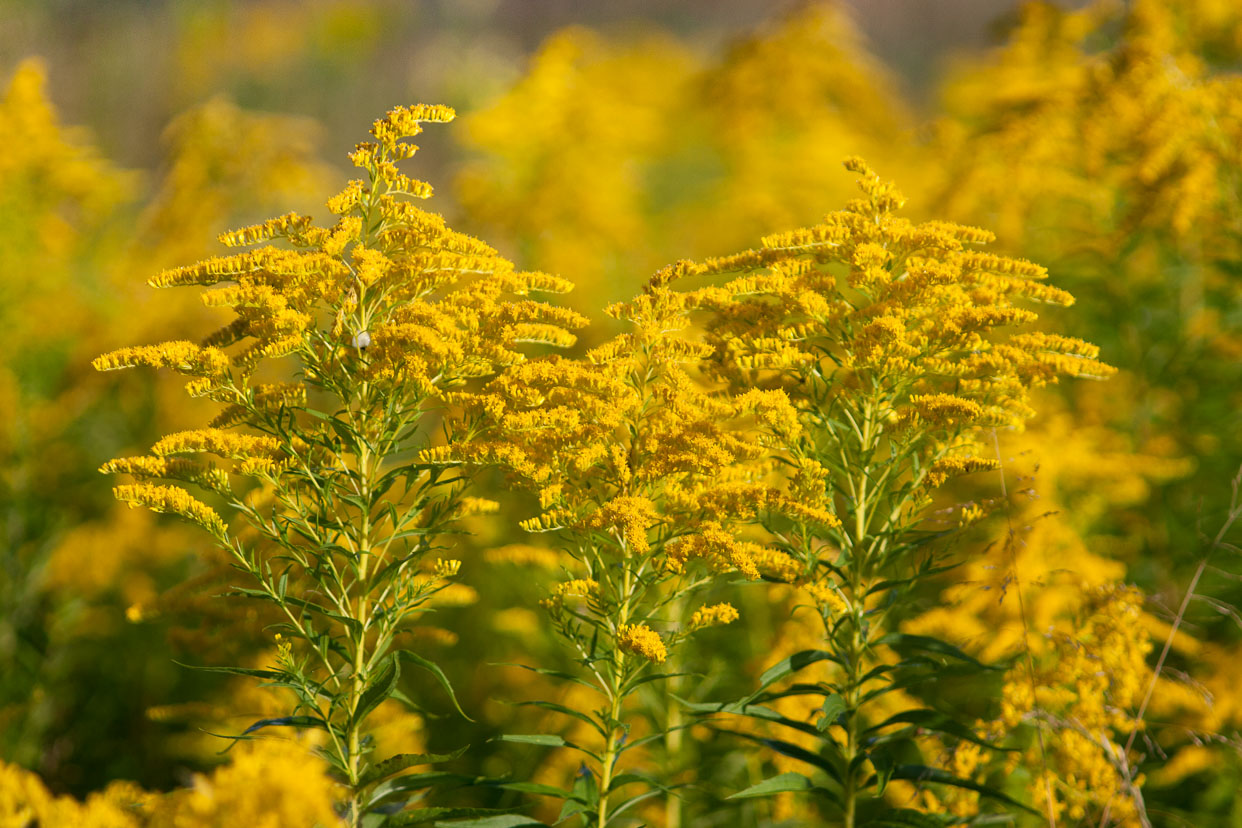
As summer slides into fall, a wonderful transformation begins happening in meadows across the area—summer flowers give way to classic autumn blossoms like goldenrod and asters. These are hugely important plants, as they represent the very last shot that thousands of species of insects have for pollen and nectar before winter settles in.
For bees and butterflies, a goldenrod field is essentially their Last Chance Cafe.
There’s a great example of this here at the Schuylkill Center. At the corner of Hagy’s Mill Road and Port Royal Avenue, a field of goldenrod is at its peak flowering right now, and its cousins aster and snakeroot are nearby– and the flowers there are literally abuzz in bees, flies, wasps and more.
In the co-evolution of insects and flowers, something remarkable happened. As the weather cools, it gets harder and harder for bees, wasps, and butterflies to fly from flower to flower searching for nectar—as the mercury drops, it is difficult for cold-blooded insects to move. So nature responded by evolving composite flowers, plants that have bundled their flowers in massive clusters, allowing a bee, say, to efficiently walk across hundreds of flowers without needing to fly.
Take dandelion, for example. Pull one “petal” out of the flower, and you’ll find the toothy-edged petal has some fuzz clinging to it. That fuzz, oddly enough, represents a complete but greatly reduced flower, and that one petal is actually the product of the ancestral flower’s petals fusing into one. So one dandelion is actually—literally—hundreds of flowers. That’s the concept, the bundling of huge floral clusters to create a target-rich environment, and the family that performed this trick is the composites, a huge and sprawling clan of wildflowers.
Goldenrods and aster are composites, offering clusters of nectar-packed flowers standing cheek-to-jowl, allowing for hyper-efficient nectar collecting. And in the yearlong parade of blossoming flowers, goldenrods and asters are the tramp clowns that bring up the rear of the parade, the absolutely last chance for honeybees to collect pollen and nectar. They’ll keep blossoming into the first frost.
In addition, in early fall monarch butterflies are in the middle of their migration to Mexican mountain valleys, an extraordinary phenomenon. Nectar-rich goldenrod’s bright yellow beacon pulls monarchs down to refuel for their extensive journey. If you are a monarch flying south, goldenrod is a critical rest stop on the highway.
But despite their ecological significance, goldenrods are reviled in our culture because just as they bloom, so does ragweed, a flower with microscopic pollen that wafts into the wind—and into our noses. So when showy goldenrod blooms—achoo!—so does ragwort, and goldenrod gets all the blame for the ragweed’s problems. It’s also at this time of year you’re treated to TV commercials of people standing in goldenrod fields waving a white flag with an exhortation to buy their hay fever medication. Memo to allergy sufferers: goldenrod’s pollen is just too heavy to get launched on the wind; instead, it sticks to the legs and bodies of insects like bees and wasps. It’s wind-pollinated flowers like ragweed that make us sniffle.
Of course, because goldenrod fields attract so many bugs, you’ll find many predators there too, like praying mantises and crab spiders hiding among the petals waiting for an unsuspecting wasp. Swallows and dragonflies cruise above the flowers—and hawks above them, waiting to grab a bird. Peacock flies lay their eggs in goldenrod stems, the eggs rubbing the flower the wrong way to produce a tumorous swelling that surrounds and cradles the egg. Look for goldenrod ball galls dotting the stems of plants in a field, fly larvae sleeping the winter in their safe little home. But downy woodpeckers know about galls, and land on the stems to peck open the galls to grab the tasty larva tucked inside.
For honey bees, butterflies, and more, goldenrod fields are the Last Chance Cafe, the last flowers of the fall season, the last chance for nectar and pollen. As such, they are critically important plants– and ecological gold mines filled with important pollinating insects.
Here at the Schuylkill Center, we’ve got goldenrod in several locations besides our Port Royal corner, like the Grey Fox Loop and down under the PECO power lines close to the river. Our butterfly meadow doesn’t have goldenrods, but may other composites are there to lure happy bugs, as daisies, sunflowers, black-eyed Susans, purple coneflower, and Joe-Pye-weed are all composites– it’s a big and wildly successful family of flowers. Morris Arboretum also has a great goldenrod field at its entrance; goldenrod even loves waste areas so you’ll find them growing in vacant “weedy” lots.
“The Secrets of a Goldenrod Field” kicks off our new season of Thursday Night Live on Thursday, October 7 at 7 p.m. via Zoom. Go to our website to register, and we’ll see you on Zoom– and next time you visit the Schuylkill Center, stop in at the Last Chance Cafe.
By Mike Weilbacher, Executive Director
